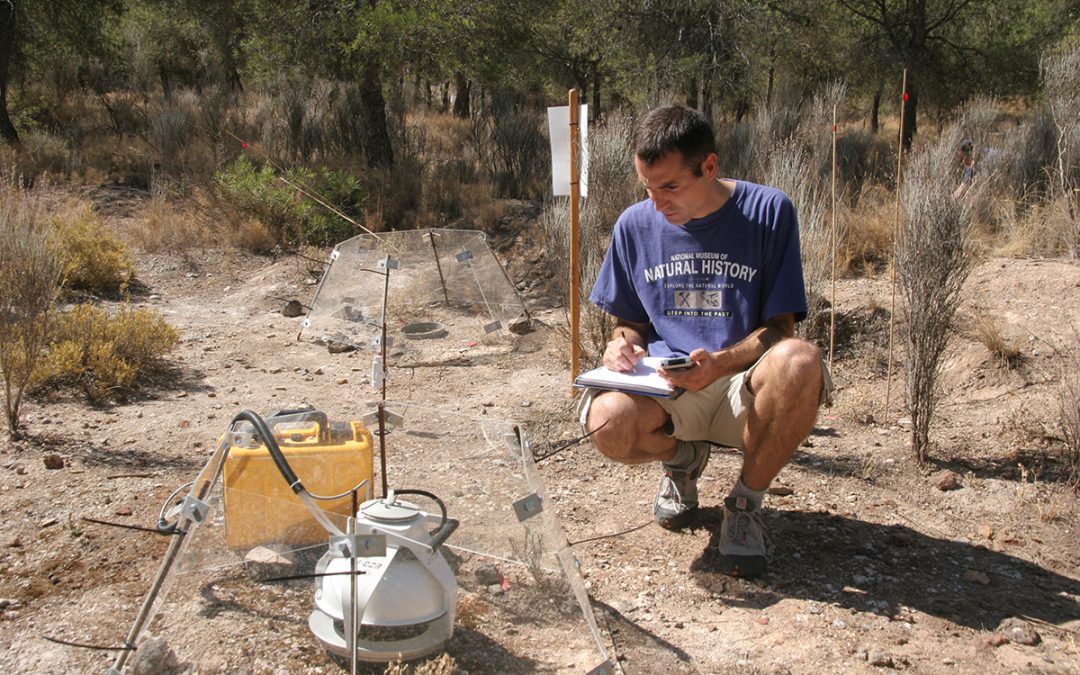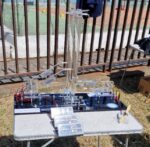Fernando T. Maestre is, year after year, one of the most quoted scientists in the world according to the Highly Cited Researchers ranking.
(Photo: Jesús Cruces)
He is a researcher at the Instituto Multidisciplinar para el Estudio del Medio «Ramón Margalef» (IMEM, Multidisciplinary Institute for the Study of the Environment) of the University of Alicante, partners of MEDNIGHT, and an expert in what he likes to refer to as arid lands, those ranging from Guadalajara to the Atacama Desert, a wide gradient from less arid to more arid that stretches over almost half of the planet.
Fernando T. Maestre’s studies are of international concern for curbing climate change, or at least for understanding its processes, in which drylands play a highly relevant role.
One of the reasons why Fernando T. Maestre enters the list of the most cited scientists year after year has to do with a macro-study he led at the Laboratorio de Zonas Áridas y Cambio Global (Laboratory of Arid Zones and Global Change) in which they analysed 236 arid systems around the world (yes, 236!), which has led to multiple publications on how changes in climate affect arid ecosystems and which are being highly cited by other researchers.
This macro-study, the first of its kind to be carried out, is now an international reference for researchers looking for data to understand what is there, what grows and how life is sustained on more than 40% of the emerged land, the drylands. Although I personally like to use the term arid zones to refer to these places. Although he personally like to use the term arid zones to refer to these places
Q: Talking about the study that made you internationally known, what is it about?
R: We sampled 236 arid ecosystems located in 21 countries on all continents except Antarctica (Argentina, Australia, Botswana, Brazil, Burkina Faso, Chile, China, Ecuador, Ghana, Iran, Israel, Kenya, Mexico, Morocco, Peru, Spain, Tunisia, the United States and Venezuela). It took more than six years and is the result of a collective effort involving more than 60 researchers from 30 institutions in 16 different countries. The numbers of this study give an idea of its magnitude: we characterised some 18 800 squares of vegetation in the field, identified more than 1500 species of perennial plants and collected more than 2600 soil samples, which we subsequently analysed in our laboratory.
We worked in ecosystems as wide-ranging as eucalyptus forests in Australia, which are forests with low tree density, grasslands on the slopes of a volcano in Peru, at altitudes of over 4000 metres, in the vast Patagonian steppe (Argentina), in the deserts of the United States, and in the esparto fields of Spain, Morocco and Tunisia.
Q: What was the main conclusion of the study?
A: We have seen that this biodiversity plays a very important role in the maintenance of arid ecosystems and their capacity to provide us with fundamental services, such as maintaining soil fertility and the production of forage and biomass. We have also seen that increases in temperature and aridity such as those predicted with climate change decrease the biodiversity of these ecosystems and their capacity to provide ecosystem services. . In countries like Spain, the provision of ecosystem services is something that most people see as something very distant (and even alien to their daily lives). But if you live in the Sahel, the fact that your livestock have grass to eat or that you have wood for cooking, heating or building a house makes the difference between being able to live there and having to emigrate. And this depends directly on the ecosystem services provided by arid ecosystems.
Q: Is desertification at the forefront of climate change-related problems?
A: Unfortunately not, because it is not given the attention it deserves. There are three major UN international conventions on the environment: the United Nations Framework Convention on Climate Change (UNFCCC), the Convention on Biological Diversity (CBD) and the United Nations Convention to Combat Desertification (UNCCD). Of the three, the convention against desertification is the least known, as if it were the little sister of environmental issues and the one with the least political influence compared to the other two. Many people do not know that there is an international convention on desertification, officially defined as land degradation in arid, semi-arid and dry-sub-humid zones associated with both climatic causes and inappropriate human activities. Climate change is a factor that increases the vulnerability of arid zones to desertification, and as desertification decreases the capacity of these places to mitigate climate change, both factors feed back on each other.
Q: What is the difference between arid zone and desert?
A: When we use the term arid zone, we are referring to areas with a particular type of climate. Different definitions have been proposed over the years; the most widely used is based on a parameter called the aridity index, which is very straightforward: it is simply precipitation divided by evapotranspiration, i.e. the ratio between the amount of water that falls as precipitation and the amount of water that is lost through evapotranspiration.
It is considered arid land when the aridity index is less than 0.65. Observing evaporation is very easy: if you put a glass of water in Alicante, it will evaporate much faster than if you put it in Berlin, for example, because the intensity of radiation and the evaporative capacity of the atmosphere in the former is much higher. Así que conceptualmente es muy sencillo: las zonas áridas son aquellas en las que llueve menos de lo que se pierde por evaporación y, por tanto, son lugares con déficit hídrico, con déficit de agua.
Arid zones cover between 41 and 45 percent of the planet’s surface. These places are differentiated by their level of aridity into dry-sub-humid zones (e.g. Guadalajara), semi-arid zones (e.g. Alicante), arid zones (e.g. Niamey), and then hyper-arid zones, which are the most arid places on the planet (deserts such as the Sahara, Gobi, Atacama, etc.). The latter are places where there is very little rainfall and very high evapotranspiration. In other words, these are the driest places in the world.
Deserts, on the other hand, are a particular type of biome, like the rainforest, the Arctic tundra and the temperate forests of North Carolina, for example. Desert is thus a type of biome that coincides with areas that have a hyper-arid climate.
Q: Places where life is scarce?
A: This is not the case. Arid zones encompass a wide variety of ecosystems that are home to amazing life, characterised by their diversity and adaptations to survive in resource-poor environments. For example, in the Atacama Desert, many plants remain “dormant” in the soil in the seed stage for years without a drop of rain. And when the rain comes, they develop and flower rapidly (the famous “desierto florido” –flowering desert–) to produce seeds that will remain dormant in the soil until the next rainfall event.
Q: Why doesn’t the Sahara flower?
A: The Sahara does not experience the phenomenon of the “flowering desert”, as can be observed in the Atacama, because it is a desert of very deep dunes that also move continuously due to the action of the wind. This does not mean that the plants found there, of which there are some, do not flower when it rains (which they do!). But if we talk about the Sahara, we have to say that this desert is home to a fascinating biodiversity, especially of mammals, reptiles and insects that have adapted to live under arid conditions and extreme temperatures, with heat oscillations of more than 30 degrees Celsius between day and night. And in such deserts we find some very interesting species. For example, beetles of the genus Stenocara, which inhabit the Namib Desert (Namibia), can condense water droplets on their backs from the fogs that frequently penetrate the Namib, thanks to the characteristics of their elytra. At some point, the droplets are so large that they overcome capillary forces and are directed towards the insect’s mouth. This mechanism is being tried to be artificially reproduced to capture water in arid places, in what is a clear example of the benefits that their biodiversity can provide.
Q: How do dryland organisms affect the global climate?
A: They are very important. When studies are done on a global scale to look at the role of terrestrial ecosystems in CO2 sequestration, for example, arid zones have traditionally been neglected. However, in recent years we are seeing more and more evidence that they are critical in regulating the inter-annual variability of the carbon cycle, which in turn is closely linked to climate.
Q: Are the few green zones in the arid zones being lost?
A: Well, I will tell you that a very curious phenomenon has been observed. In the last thirty years, arid zones have been greening up in many parts of the world. There is a lot of scientific discussion on this subject, but what is undeniable is that, while there are arid zones that are being degraded and losing vegetation as a result of climate change, many others are gaining vegetation and becoming greener, and this is mainly due to the effect of CO2.
Q: How? How come rising CO2 levels benefit them?
A: Plants need to carry out photosynthesis in order to grow. In this process they take CO2 from the atmosphere and make their own food, releasing oxygen in the process. To take in CO2, the leaves of plants have holes called stomata, which open to capture this CO2. And it happens that when the plants open them, they in turn lose some of the water inside. As there is now more CO2 in the atmosphere, the stomata are open for less time to capture the same amount of CO2 and, therefore, the plants lose less water. Thus, with the same amount of water in the soil, plants can grow more. Thus, with the same amount of water in the soil, plants can grow more.
Q: Will green spaces then increase?
A: There is a lot of uncertainty as to whether this greening will continue in the future, because, of course, CO2 concentration keeps increasing, but soil evaporation is also rising, as the temperature goes up. In addition, rainfall is becoming more and more variable, and in some areas, such as the Mediterranean basin, models suggest that it is going to be significantly reduced. This is why there is so much uncertainty as to whether this “fertilising” effect of CO2 will be maintained in the coming decades. The latest evidence suggests that it will not, and that we will start to lose vegetation due to rising temperatures and associated evapotranspiration.
Q: To green the world, is it time to plant trees non-stop?
A: I love trees, but the problem is that trees use more water than shrubs and herbaceous species. And we are planting trees in places that are not going to be able to sustain themselves in 40 years’ time because of climate change, so they are doomed to fail. In countries like ours we cannot start planting trees “madly”: we have to take into account that there are places that were able to maintain tree cover in the past but will not be able to do so in the future.
We like to plant trees because we like green, we don’t like brown. But if you get on a plane, from above you can clearly see that most of Spain is brown. Three quarters of Spain is brown, there is not much green. And we have to appreciate our land for what it is. I am from Alicante, born and raised here, trained as a person and as a biologist in these environments, for which I have a special appreciation. But when we talk about nature, people in Alicante, Murcia, Seville or Guadalajara usually think of a dense forest, a tropical rainforest or a flower from the Alpine mountains, and not an esparto grove in Alicante, which is what we have. This is the nature we have in a large part of our territory.
Q: Is our nature brown?
A: This is the case in a large part of our territory. Spain is a country with an abundance of species adapted to our climate, such as esparto grass, which, together with sparse and scattered vegetation, in many places gives our landscapes their characteristic brown colour when seen from the air. The darker the vegetation, the greener it is, the more radiation it absorbs and the more it heats up and, therefore, the more water it loses. Our brownish, whitish tones reflect light, heat up less, and lose less water.
Q: Wasn’t our country once covered with trees?
A: No, that is not true. This is a myth passed down from generation to generation for decades, but it is very unlikely that a squirrel could climb a tree in Cadiz and reach Galicia by jumping from tree to tree. The Romans already spoke of the Campus Spartariusto refer to Cartagena. Here there has been esparto grass in abundance for at least 2000 years. If we do not appreciate our arid zones, we who live in and from them (let us not forget where much of the food we eat comes from), how can we look after them!







